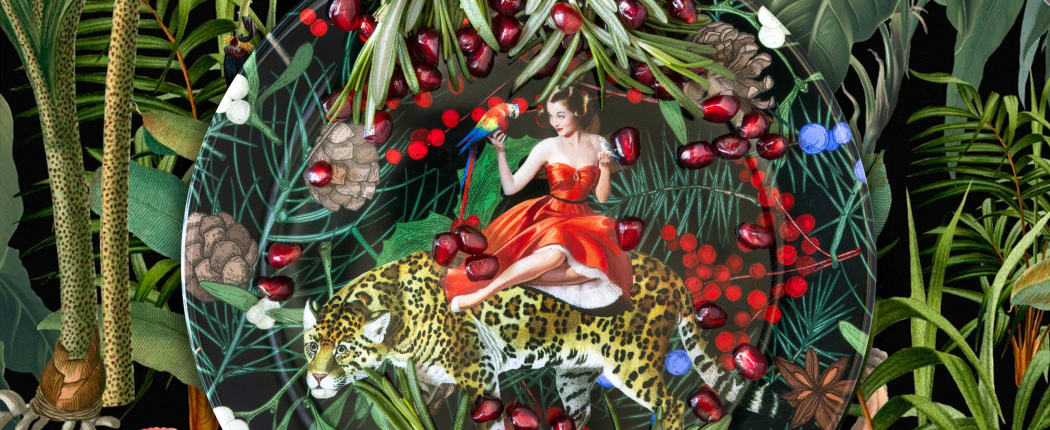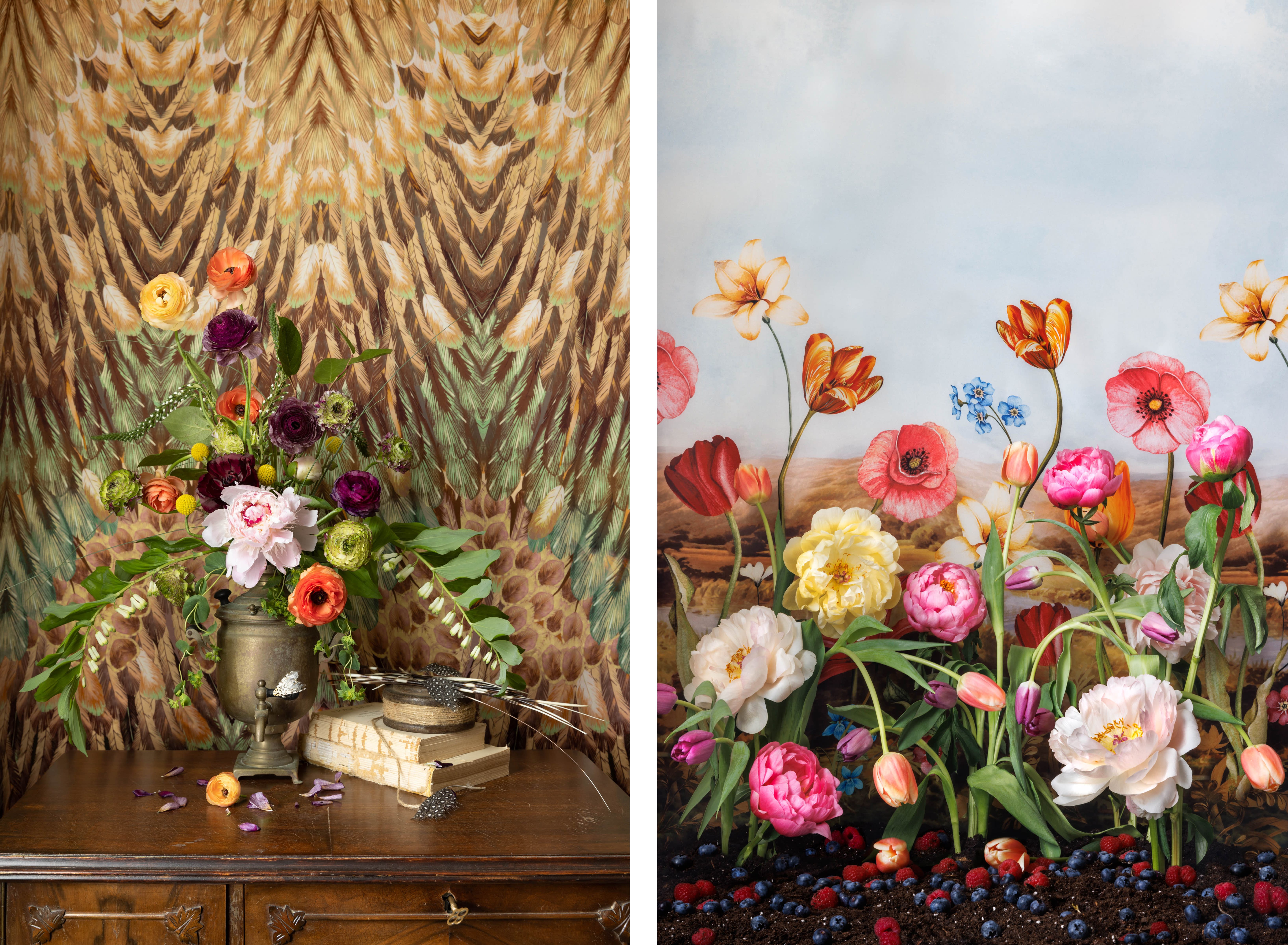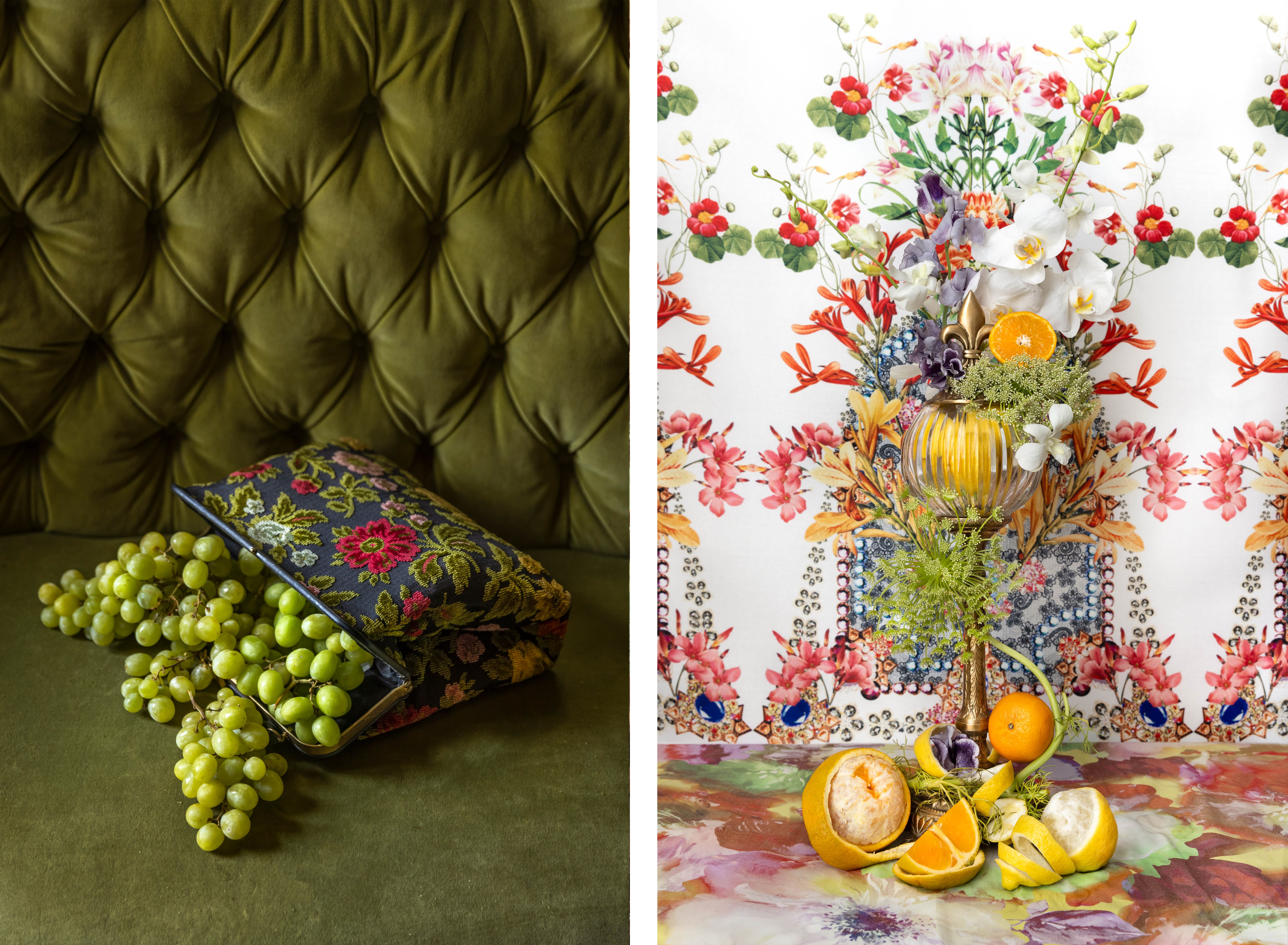
The production of artwork flows from the release of something inside an artist that drives their creative expression. JP Terlizzi is an artist that uses his abilities to envision and build ephemeral works of art that are memorialized as photographs. In Creatures of Curiosity and Garden Symphonies, Terlizzi revisits his earlier works in The Good Dishes and Holding Arabesque, with several new twists. Terlizzi comments that, for him, “The Good Dishes integrates memory, legacy, and metaphor with my response to loss. Without fail, when it came to the family’s fine china, that item was always given to the person that most cherished its memory and sentimental value.” Following that series, the Covid crisis opened a door to additional creative expression: “Holding Arabesque was inspired by the shifts in my life brought on by a result of the pandemic. It was about craving stability in a time of instability. I built these food totems to push their stability as my response. Humor and Nostalgia are known coping mechanisms we resort to when we experience high stress or trauma… I was craving happier times.” As our culture began moving past social isolation, his visual engagement became bolder, first evolving into Garden Symphonies, and then Creatures of Curiosity.
Terlizzi challenges his previous still-life compositions, building upon them and moving forward with Garden Symphonies. Terlizzi comments: “The pandemic forced me to enjoy quiet time and appreciate simple things. I came out of it with a strong need to visit two places that bring me the most joy… make me slow down and appreciate my surroundings. Most of the work from Garden Symphonies came from these places. Garden Symphonies is about harmony and beauty, about darkness and light. It's about indulgence and slowing down and seeing beauty in the simple things that might get overlooked. I love color, I love patterns, and I love playing with food, these are signature elements of my photographic style, but in Garden Symphonies I wanted to introduce a darker palette to create a quieter, more somber mood. Where Holding Arabesque was more whimsical and playful, Garden Symphonies introduces florals which I tried to use in unconventional ways.” Terlizzi’s close attention to details such as lighting, staging, and content allow him to create a unique body of work even while referencing similar compositions from Holding Arabesque.

Left: JP Terlizzi, Solomon's Seal, 2023
Right: JP Terlizzi, A Parade of Peonies, 2022
In the series Garden Symphonies, Terlizzi takes a detour from fine china plates and a birds-eye perspective that he used in The Good Dishes. In Solomon’s Seal of Garden Symphonies, there is a return to the level straight-on perspective seen in many traditional still-life paintings and photographs with an arrangement of objects on a table surface, feathers, and a moth on the spout of a pewter colored samovar. There are no plates, and no fruit or vegetables as in much of his earlier works. The composition is similar to works seen in another exhibition of still-lifes at Foto Relevance that was discussed in the commentary “Still Life Stories: Fabled Flora” (02/04/21). Terlizzi commented: “Food, flowers, and objects have a rich and captivating history that has influenced cultures, religions, and civilizations throughout time. From ancient Egypt to medieval Europe, the Victorian era, and the present day, they have played a significant role in various rituals, ceremonies, art, and culture. Our relationship with food and flowers is unique and reveals a profound connection between humans and nature. They require gentle handling, watering, and nurturing, and their multi-sensory experience has been shown to significantly impact our mental and physical health.” Also from the Garden Symphonies portfolio, A Parade of Peonies is, at first glance, a turn toward a seemingly more conventional floral scene with a straight on view of flowers, until one realizes the layering of the two-dimensional floral backdrop, the three-dimensional flowers in the middle, and the berries spread throughout the soil in the foreground. This piece stands alone compositionally from Terlizzi’s previous work.

Left: JP Terlizzi, A Bag of Grapes, 2021
Right: JP Terlizzi, Citrus Lace Zest, 2023
In A Bag of Grapes, Terlizzi skillfully uses chiaroscuro to give volume and weight to the contents of this photograph, as in old Dutch style painting. The dramatic lighting brings out the texture in the buttoned sofa and the knitted fabric texture of the purse, where the red of the flowers pop against the contrasted shade of the green grapes and the darker forest green of the sofa, and yet darker background green-blue of the cornucopia purse, from which grapes spill out. Terlizzi elaborated on his motivation: “Garden Symphonies explores the intricate interplay of harmony and beauty woven within the tapestry of nature. The series of images expertly juxtaposes darkness with light, creating a narrative that warmly embraces the interplay of indulgence and abundance. These images act as an allegory for the ever-changing nature of time, adeptly capturing the transient essence of earthly existence. The collection invites you to "hear with your eyes" and celebrates the vibrant hues present in the ephemeral beauty of flowers, the succulence of fruit, and the symbolic richness embedded in textiles.” He then pivots back to a constructed still life in Citrus Lace Zest with a vase filled with beautiful florals, fresh oranges and lemon, peeled and cut at its base, as well in the floral arrangement itself. The careful one-piece circular peal of the lemon and orange was seen previously in the very first of the Good Dishes series, Empress Royal Hague Blue Floral with Orange and in the later Gracie Lemonata with Lemon, and with the exception of a much brighter playful background. However, a companion piece in Garden Symphonies, A Study in Bordeaux, returns to a dark, somber background, as in A Bag of Grapes. A Study in Bordeaux harkens back to a cross over between the Wedgwood Hibiscus with Red Onions of The Good Dishes work, sans the dishes, and the use of a vase for a traditional straight-on look, rather than hovering-over-a-table perspective used in Holding Arabesque against a very dark background reminding us of the Cascade of Orange. In a Cascade of Orange, there is a contrast to the fruit in A Bag of Grapes as the oranges, in a random fashion, cascade off the blue couch onto the old thick wood boarded floor. Again, the lighting is reminiscent of an old Caravaggio or Rembrandt painting of the 16th and 17th centuries, respectively. Terlizzi continues this experimentation with arrangements and light in Sliced Pears and Grape Noir with great success.
Dramatically different from his other work, Terlizzi suddenly raises his visual voice louder than it ever was before in Creatures of Curiosity. A fresh sense of wildness and abandon appears in these images. When asked what triggered this visual/emotional outburst, he says “Creatures of Curiosity is about indulgence but also temptation. All the dishes used are from my collection of tableware. I became a grandfather recently, and I started to think about legacy and what legacy I will be leaving behind for my children and grandchildren. Will they want my dishes, or my collection of stuff I have acquired from my travels? Will they even want my photographs? In creating Creatures of Curiosity, I kept thinking about indulgence and what that means. I wanted this collection of dishes to be richer in color, more over-the-top, and more chaotic in patterns. I wanted darker palettes, nothing light like the original patterns of the dishes. I wanted to see how much I could push the food styling and the design without it becoming gaudy, yet still maintain the beauty the dishes are known for.” Terlizzi takes this exciting turn adding surprising content that departs from a more placid past.
The new elements in Creatures of Curiosity — darker plates and darker backgrounds — are entwined with animals, reptiles, birds, and insects. The artist’s work in The Good Dishes was first examined in 2020 within a commentary written for his first-ever exhibition of the work: “The Good Dishes: The Art of JP Terlizzi,” (July 14, 2020). In asking Terlizzi about what may have influenced the direction for Creatures of Curiosity, he says “I grew up in a Roman Catholic household, I have a fascination for religious stained glass, I love Italian Religious Renaissance paintings, Caravaggio, and The Dutch Masters, and I am sure their influence unconsciously made their way into Creatures of Curiosity.” He added, “Some of the tablescapes are wallpapers that I manipulated, some are sourced imagery that I created and colorized. The backgrounds are darker and more colorful, which was intentional. I wanted them to feel indulgent and chaotic, yet compliment the beauty of the dishes and styling of the food.”

JP Terlizzi, E Shipley Zambezi with Blueberry Onion Cup, 2023
JP Terlizzi, Gien Jardin du Palais with Broccoli Tiger Beets, 2023
In E Shipley Zambezi with Blueberry Onion Cup, we see this complexity with the variety of fruits, yellow cherry tomatoes, cherries, and blueberries against a dramatic, visually complex tablecloth with a green-blue thick jungle of broad-leafed plants, the white background of the plates directing the viewer’s eye to a Doctor Seuss-like bird of paradise rising to the sun with imaginative leopard-spotted elephants, a design inspired by Jules Verne`s adventure stories and the designer’s travels to Botswana. Looking at Gien Jardin du Palais with Broccoli Tiger Beets, a large tiger holds attention at the center of the image, in the center of a plate, viewed from above on a constructed tablecloth of a dense jungle with Great White Egrets and other beautifully illustrated birds. With a nod to his past work, an arrangement of broccoli and beets spill out of a cup onto a dinner plate and smaller salad plate. The viewer immediately feels amidst a wildness. In Myrtle and Mary Paradise Lost with Orange Key Lime, the design features a spread of evenly space lines across the entire image, as if to give the viewer the sense of Toucans and other birds, leaping leopards and prowling tigers, are caged. Equally enjoyable are the slithering serpents from the cream server across the imagined field that is the tablecloth background in Spode Creatures of Curiosity with Goose-Cranberry. There are seven other images in this 10-piece series for Creatures of Curiosity to entrance us.
In his new bodies of work, JP Terlizzi shares with us something very special: “I think the feeling that The Good Dishes conveys is universal across all cultures. A table is where we gather with loved ones, share stories, make memories, and enjoy each other’s company. It's where we make connections.” Revisiting the genre of still-life images with Garden Symphonies and Creatures of Curiosity, he continues the customs of family gatherings with a flourish. Experimenting with prior work to create something new and different, his feelings are released to us, the viewer. “I LOVE patterns too much to abandon them. I am having fun playing with ideas and images and seeing what I respond to.” We see how an artist uses light to provide shape, weight, and depth. However, Creatures of Curiosity signals both an end and a new beginning. He states, “This is definitely it. I am done. I am very pleased with the way these new images came out and I would like to leave the series knowing that I have explored everything that I set out to. The series started with my godmother's dishes, and they ended with my dishes — it's a very nice bookend and a beautiful testament to a woman that I loved and adored so much.” To engage with all of JP Terlizzi’s work is a journey, a rare opportunity for an open dialog with an artist throughout years of their life. It is a journey many of us share with him. He takes us with him as he, and we, sought stability in period of the Covid pandemic to emerging back into engagement with society with a roar!
